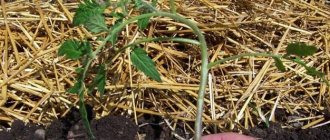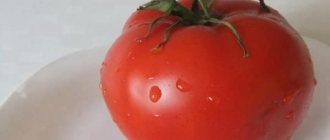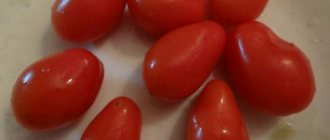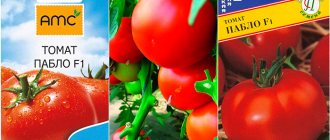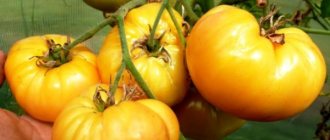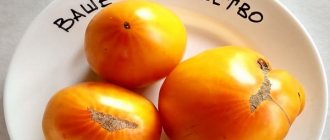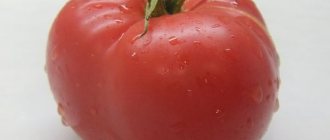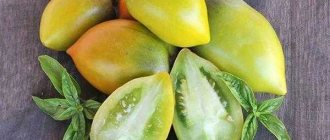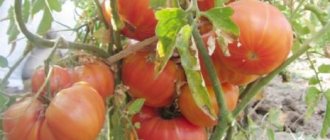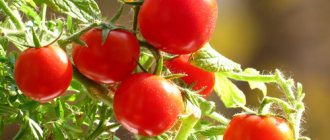The tomato with the self-explanatory name Delicacy boasts not only excellent taste, but also unpretentiousness. It is grown by summer residents on their plots, by gardeners who do not have time to bother with complex care, and even by those who do not have beds, but only boxes on the balcony. It grows everywhere.
| Height | Landing location | Ripening time | Fruit color | Fruit size | Origin | Fruit shape |
| short | Greenhouse, Open ground | Mid-early | Pink | Average | Variety | Round |
Description of the variety
First of all, you should understand the very definition of the Delicatessen variety in order to avoid possible discrepancies. In printed and electronic publications there are such varieties of tomatoes: Moscow delicacy, Pickling delicacy, Italian delicacy and even “Mega super productive and popular cherry tomato Delicacy F1”! Such a number of namesakes can only be explained by the special attractiveness and relish of this word itself.
Despite the fact that all of these are varieties of the variety, only the first of them has official variety status. The Moscow delicacy was included in the State Register of Breeding Achievements approved for use in the Russian Federation in 2001. But even he, like the “self-proclaimed” varieties, has nothing to do with the subject of our review. In addition, in most of the same publications, the registration date of the Delicatessen tomato variety is mistakenly attributed to 2001. In fact, it was added to the State Register only in 2007.
Attention! Do not confuse Delicacy with other delicacy-named varieties!
The characteristics and description of the variety, without excesses or discrepancies, are recorded in the original source. Here is an extract from the registration card:
- Included in the State Register of the Russian Federation for cultivation in open ground in private plots (personal subsidiary plots).
- Requires staking and plant formation. Salad. Mid-season. The plant is determinate.
- Medium sized leaf, green. The inflorescence is simple. Pedicel with articulation.
- The fruit is round, smooth, of medium density. The color of the unripe fruit is light green, the mature one is pink. Number of nests – 4 or more. Fruit weight – 100-120 g. Taste is good.
- The yield of marketable fruits is 6.1 kg per 1 sq. m.
- Drought resistant. Resistant to crown and root rot.
Distinctive features
The variety is determinate, standard - a low-growing bush reaches a height of only 40-60 cm. The stems are strong, but during the period of ripening and fruiting they require garter, since the fruits are large. The variety was cultivated for cultivation in open ground, and it is so unpretentious to environmental conditions that some tomato enthusiasts do it on their balcony.
Fruit characteristics and yield
The fruits are large, round in shape, slightly flattened at the poles. They have an attractive soft pink or hot pink color. 1.5-2 kg of tomatoes are harvested from a bush per season. Depending on the planting pattern and density, the yield ranges from 6 to 8 kg per 1 sq. m. The yield is not the highest (after all, the variety is determinant), but stable.
Description
The bushes are determinate, standard type, the ripening period is mid-early, usually 100-110 days pass from the emergence of seedlings until the moment of ripe fruits. The variety can be grown both in open beds and in shelter; some even plant “Delicacy” in pots on the balcony.
The height of the plants can range from 40 to 60 centimeters, the stems are quite strong, the leaves are of normal size and green. The inflorescence is simple, the stalk has an articulation. Tomatoes have 5-6 chambers, contain 5% dry matter, they are round or flat-round in shape, weigh 85-120 grams, the skin is smooth and of medium density. At the ripe stage, the fruits turn a rich pink color. The taste of the fruit is excellent. The yield is quite good: 1.5-2 kg per plant, which is up to 16 kilograms per square meter when planted per 1 square meter. m. 8 bushes.
You can eat it fresh or add it to various dishes. Also, this variety is perfect for any type of preservation; tomatoes tolerate heat treatment well and do not lose their original taste and appearance.
How to grow seedlings
It is better to purchase seeds from a reliable and trusted manufacturer. But even in this case, it is necessary to carry out their pre-sowing preparation. It is advisable to calculate the sowing time depending on the climatic characteristics of the growing location. Sowing begins at least 60 days before transplanting the plants to a permanent location. The delicacy is a mid-season variety, that is, before fruiting begins, it must ripen in the beds for at least another 1.5 months.
Seed preparation
In some publications and on the Internet you can find the most extreme recommendations for sowing and preparing seeds. Following them, virtuoso gardeners do without any pre-sowing preparation of seeds and plant them immediately in open ground or flower pots. Perhaps this approach would work in the south, but even there you need to be prepared for significant losses of seed and future harvest. Therefore, it is safer to stick to the traditional scheme.
First of all, for disinfection, the seeds are soaked for 20-30 minutes in a 1% solution of potassium permanganate, then washed and immersed in any growth stimulant. These can be “old-fashioned” recipes such as aloe juice diluted with water in a ratio of 1 to 1 or a solution of honey (1 teaspoon per glass of water), as well as modern formulations: “Epin”, “Gumate” or “Energen”.
The drug "Epin" has proven itself well, but it must be used carefully, since it is a concentrate. For soaking, 3 drops per 100 ml of water are enough. Seeds wrapped in gauze are kept in a growth stimulant for 12 hours to 24 hours and sown without waiting for hatching. Planting material treated in this way produces vigorous shoots.
Container and soil
For seedlings, take shallow trays that are filled with nutrient substrate. It can be purchased at a specialty store. It is usually packaged in paper bags marked “for tomatoes and peppers.”
It’s easy to prepare the substrate yourself: take 2 parts of peat, one part of turf soil and compost, and half of sand. It is recommended to add one glass of wood ash and complex fertilizer, which includes phosphorus, potassium and nitrogen, to a bucket of this mixture. Such soil contains all the macro- and microelements necessary for the normal development of plants.
Sowing
Sowing is carried out to a depth of no more than 1-1.5 cm. The width between the grooves should not be less than 3 cm. If in the future you do not plan to pick into separate containers, the distance between the seedlings is increased to 8-10 cm. The seeds are sprinkled with earth and watered abundantly, then cover with film. The optimal temperature for germination is 22-25°C. In the future, the crops must be regularly ventilated (at least once a day) and watered at least once a week.
Growing and care
The film is removed after the first leaves appear. At this time, they pick into peat pots for more comfortable development of each plant and preservation of the root system when transferred to a permanent place. However, you can leave the seedlings in trays. Then the containers with the sprouts are moved to a well-lit place.
To strengthen the sprouts, they need to be fed. For example, the already mentioned remedy “Epin”. For spraying, prepare a solution: 6 drops of concentrate per 500 ml of water. The procedure is carried out once every two weeks, and even less frequently if the sprouts develop favorably. It is also recommended to harden them before moving them to a permanent place. This procedure consists of taking the seedlings out into the open air for a week, gradually increasing the time from 20 minutes to 2 hours a day.
By the way! Fertilizers not only increase the growth and durability of bushes, but also significantly improve the taste of the fruit.
Tomato Delicacy: planting varieties
Moscow tomato Delicacy: video about the variety
- Pour fertile soil into the container you have chosen for Delicatessen tomato seedlings, then make holes 1 cm deep, with a distance of at least 2 cm from each other - this will allow you not to thin out the seedlings in the future.
- Then we water the seedlings daily until the first shoots appear - this is done so that a crust does not form, which prevents the “pecking” of the Delicatessen tomato seedlings. Further, as the seedlings appeared, watering is carried out approximately once a week.
- Delicatessen tomato seedlings need to be created with comfortable conditions - we place them in a warm, bright place, plant them in a timely manner and water them. Before planting the plants in a permanent place, it is necessary to gradually harden them, this will allow them to adapt faster.
- In the area prepared for transplanting Delicatessen tomatoes, holes are made. Next, carefully remove the plant from the container along with the earthen lump and transfer it to the prepared hole, after which we sprinkle it with earth and water it.
How to grow tomatoes
The agricultural technology for growing Delicatessen differs from the cultivation of other varieties and hybrids of determinate type tomatoes. Despite the fact that the bushes of this variety are low-growing, they will require special care throughout the growing season. Each bush requires support, because without a garter it can break under the weight of the fruit. Plants also need timely pinching and formation.
Landing
Depending on the geographical location and climatic characteristics of the area, the timing of transplantation to a permanent location varies between the second half of May and the beginning of June. Again, depending on the specific conditions, the location is chosen - in a greenhouse, open ground or flower pot. In any case, the place should be sunny and protected from the wind.
Light types of soil with pre-drainage are preferred for planting. The soil must be disinfected by treating with a 1% solution of potassium permanganate and fertilized with phosphorus-potassium fertilizer, which promotes the development of the root system.
“AVA” is potassium monophosphate, to which nine more microelements have been added in the form of additives. An excellent result is obtained by mixing a new type of fertilizer with good old wood ash in the proportion of 5 g of “AVA” to 3 cups of ash per 1 square meter. m. Germination is doubled and the ripening period is reduced.
Seedlings are planted in pre-prepared depressions the size of peat pots or lumps of earth with an intact root system (if no picking was carried out) on pre-formed beds. The row spacing is 70 cm, and the distance between plants in a row is 30-40 cm.
Important! Simultaneously with planting, supports are installed for each bush. Doing this later is not recommended, so as not to damage the already formed root system of the plants.
Care
The first watering is carried out immediately after planting. The next one – no earlier than in 5-7 days. The delicacy tolerates lack of moisture and even drought well. The seedlings are watered with moderately settled warm water, weeded and the top layer of soil around them is regularly loosened to ensure complete aeration and prevent root rot.
Growing and forming bushes require much more attention and labor. Timely removal of leaves and excess shoots allows the plant to mobilize all the resources of nutrients for ovary and fruit growth. Therefore, the bush is formed into only one, or less often, two stems. To do this, remove all the stepsons, except for the one located under the first flower brush.
As the plant thus formed grows, it is tied to a support. Gartering, like pinching and pruning, is carried out throughout the entire growing season. All side shoots and stepsons are removed several times per season. Tomatoes also periodically require fertilizing with complex mineral fertilizers - at least 3-4 times during the growing season.
Important! The delicacy accepts phosphorus-potassium mixtures well. Feeding is especially necessary during the period of flowering and formation of ovaries.
Features of cultivation and possible difficulties
Further formation depends on growing conditions. The leaves on the bushes of this tomato variety grow thickly, regardless of watering and fertilizing. The lower part of the tomatoes is freed from greenery completely up to the first ovary. The higher leaves are removed as needed, exposing the ripening tomatoes to sunlight.
Diseases and pests
Of the most common tomato diseases, the Delicatessen variety is most often susceptible to brown spot and powdery mildew. Brown spot affects plants both in greenhouses and in open ground. The main condition for its prevention is a decrease in soil and air humidity, for which watering is reduced and greenhouses are ventilated.
To get rid of this disease, use the fungicide “Zaslon”. Before therapeutic spraying, all damaged shoots, leaves and fruits are removed from diseased bushes. The spraying itself is carried out in the morning and evening once every 10 days. The solution is prepared in the following proportion: 2 caps of fungicide per 1 liter of water.
Powdery mildew (or powdery mildew) is the common name for a contagious disease caused by two types of fungi. It is easier to follow measures to prevent it: alternate planting crops in the garden (plant tomatoes in one area no more than once every 3-4 years), disinfect the soil before planting, often loosen the soil to saturate it with oxygen, ventilate greenhouses, avoid nitrogen fertilizers.
If the first signs of the disease appear, you must immediately spray the bushes with potassium permanganate (2.5 g of potassium permanganate per 10 liters of water). Powdery mildew is quite effectively combated using folk remedies. For example, this: in 10 liters of hot water, stir 2 tablespoons of soda and 10 g of laundry soap shavings. All plants are sprayed with a cooled solution when the first signs of infection appear, and after 2-3 days the treatment is repeated.
The most common pest of this tomato variety when grown in open ground is the Colorado potato beetle. Insects are collected manually, after which the bushes are treated with an insecticide - the drug "Confidor", which is available in the form of a suspension in ampoules or in the form of convenient sachets with powder of 1 and 5 g. The consumption rate is 1 g per 10 liters of water, which should be enough for 200 sq. m.
Slugs are fought by loosening the soil, sprinkling with a mixture of ground hot pepper and mustard powder. Consumption – approximately 1 teaspoon per 1 sq. m. The nightshade miner also loves this variety; the drug “Bison” is used against it. It is available in 1 ml plastic ampoules, which should be diluted in 10 liters of water. This should be enough to process 100 square meters. m landings.
In greenhouses, the main enemy of the Delicacy is the greenhouse whitefly. It can be limed using the same preparation “Confidor” in the same concentration. When grown on the balcony, no problems with harmful insects were identified.
Attention! Insecticides are not used in the mass flowering phase of plantings.
Diseases and pests, how to deal with them
As mentioned earlier, the Delicatessen tomato is drought tolerant, and it is also resistant to root and blossom end rot.
It should be noted that it is vulnerable to a disease such as brown spot - it is often found in the southern regions and applies to both tomatoes grown in open ground, as well as those grown in greenhouse conditions. For control, as well as for preventive purposes, it is recommended to use the drug “Zaslon”, which you can purchase at any specialized store, and you should also reduce watering and ventilate the greenhouse more often.
Also, the Delicatessen tomato variety is vulnerable to diseases such as powdery mildew, a fungal disease that causes a white coating to form on the foliage. “Profi Gold” helps perfectly to combat this disease.
In addition to diseases, the Moscow tomato variety Delicatessen is also susceptible to some insect pests. One of the most popular pests of tomatoes in open ground is the Colorado potato beetle; it is very dangerous for the growth, development and even life of the plant. After detecting a beetle, you should immediately inspect all the plants and collect the beetles and larvae by hand, and then treat the plants with Prestige.
In greenhouse conditions, whitefly is dangerous for tomatoes; to combat it, it is recommended to use the drug “Confidor”.
If slugs are detected, an explosive mixture of pepper and ground mustard will come to the rescue. This mixture is added at the time of loosening the soil at the rate of one teaspoon of mixture per square meter.
Harvesting and application
Delicatessen fruits have excellent taste and are good fresh. They are medium in size, so they are suitable for whole-fruit canning and barrel pickling. Due to the low dry matter content in the fruit (up to 5% - one of the best indicators among tomatoes), these tomatoes are suitable for making juices, pastes and complex preserved products - lecho, ketchups and sauces.
Advantages and disadvantages of the variety
The benefits of delicacy tomatoes are easy to list:
- high taste qualities;
- the ability to grow at home on the balcony;
- resistance to lack of moisture and drought;
- resistance to most diseases;
- duration of fruiting - until the first frost;
- versatility of fruit use.
Disadvantages include not the highest yield, demanding fertilizing during the plant growth stage. No other significant deficiencies were identified.
Reviews
“I really liked the hybrid “Delicacy”. It is ideal for growing at home, in pots, hanging baskets, small boxes and other containers. Very beautiful bushes. They have dark leaves and bright red tomatoes with a diameter of 4 cm. The plant is productive, blooms well, and fruits are formed before the onset of frost” (Alena)
Having examined the characteristics of the “Delicacy” variety, we can conclude that it has tangible advantages. For example, unpretentiousness and the ability to grow on a balcony, thanks to its compact size. So you can get a decent harvest even without favorable conditions for vegetable growing.
Other types
Concluding the review, it is worth mentioning those same “namesakes”: Moscow Delicacy, Salting Delicacy, Italian Delicacy, Raspberry Delicacy F1 and Cherry Delicacy F1. Their main difference from Delicatessen is that all these varieties and hybrids are indeterminate, that is, tall. This means that in terms of yield they are superior to the Delicatessen variety - over 10 kg per 1 sq. m.
In addition, they differ in the shape and weight of the fruit. For example, Moscow, Zasolochny and Italian have a cylindrical or pepper-shaped shape, and cherry Delicacy F1 has a plum-shaped shape and small fruits in weight - only up to 80 g, while the fruits of the hybrid Pink Delicacy reach 200 g. In general, these tomatoes can be confused with It will be difficult to become a real delicacy.
Farmer reviews
The formal characteristics and description of the variety do not fully answer the question of why gardeners like the Delicatessen tomato so much. Let's turn to the gardeners themselves for an answer.
Marina Zotova, Moscow region: “For several years I have been living in the summer at my dacha, there is a small plot. I'm certainly not a professional, but I'm no longer a beginner either. During this time, I became familiar with some of the subtleties of growing different crops. My family especially loves tomatoes, so I plant most of the area with them. Last year, a neighbor shared the seeds of the Delicatessen, I planted them in April, by mid-June I planted them in the garden, in August I already had my own tomatoes, and the fruiting period is quite long, I picked a lot of the fruits green, since it got colder, they were already ripening at home.”
Anna Gudkova, Saratov: “I’ve been planting this variety for more than 5 years, the harvest is always stable, the tomatoes themselves are to my taste and my family’s, suitable for any type of preservation. The germination of the seeds is excellent, the seedlings have never gotten sick over the years, I don’t know if this is due to natural immunity or if I was just lucky. They are completely unpretentious in care and are suitable for those who are just learning to grow tomatoes.”
Features of planting and growing tomatoes
Apparently, the only danger facing a gardener when growing a Moscow delicacy tomato is the tendency of its seedlings to stretch and outgrow. Even when seedlings are kept in spartan conditions, they have to be planted obliquely in order to deepen the stem. The timing of sowing seeds for seedlings is usual - 55–65 days before planting them in the garden; there are no special care requirements.
Seedlings of the Moscow delicacy often have to be planted obliquely
The planting scheme depends on the preferences of the gardener; 3–4 plants are placed per square meter. Water this tomato moderately; it does not require a lot of moisture. There is no need for frequent feeding. If the bed is well filled with fertilizers, you can even skip the first regular fertilizing (two weeks after planting the seedlings), and only immediately after flowering, water the bed with an infusion of ash, and repeat the procedure after 2-3 weeks.
Timely stepsoning is of greater importance. The variety is prone to thickening of the bush, so all the stepsons, except for one of the strongest, chosen as the second stem, are broken out weekly. Soon after the first ovary appears, all the leaves below it are also torn off. In the future, they try to remove foliage that strongly shades the ripening tomatoes from the sun. The stems are tied to stakes several times a season.
